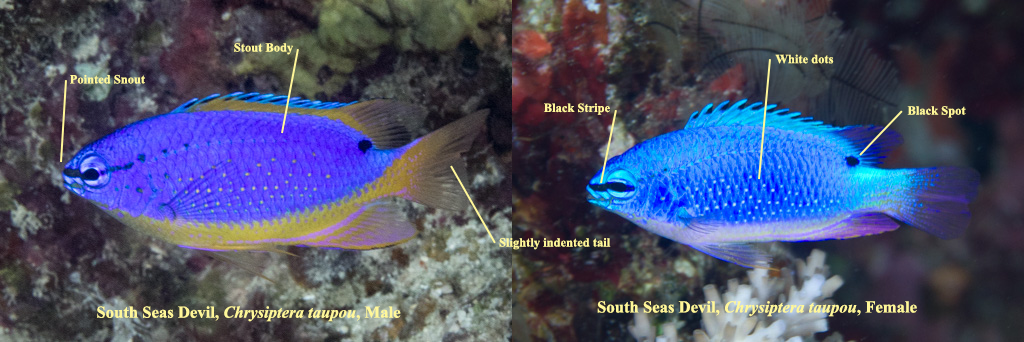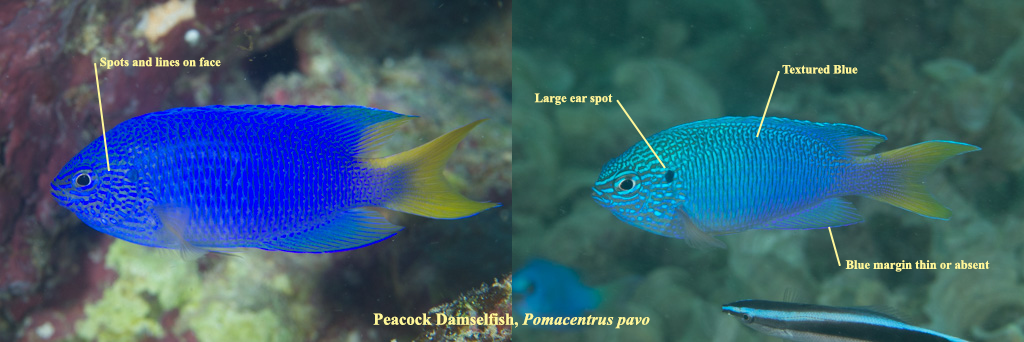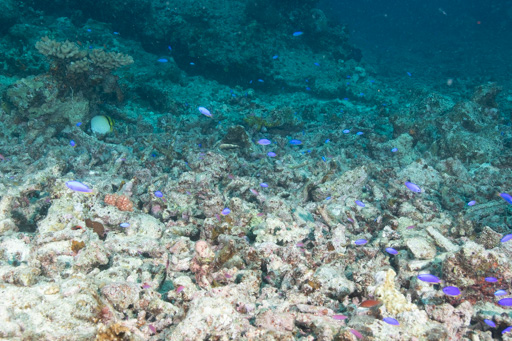Bright Blue Damselfishes: Neon Damsel, Peacock Damsel, South Seas Devil
Here is how to separate the three bright blue damselfish species found in Fiji: Pomacentrus coelestis (Neon Damsel), Pomacentrus pavo (Peacock Damsel), and Chrysiptera taupou (South Seas Devil). Note that these three species are the only bright blue damsels in Fiji; there are several other species present in other parts of the Indo-Pacific which are not considered here.
At first glance each of these are quite similar. However, if you know which features to look for, they can be identified in the field, often from a distance.
First, figure out if you are looking at a Chrysiptera (South Seas Devil) or one of the two Pomacentrus species (Neon or Peacock Damsels). Fishes in the genus Chrysiptera have a slightly different shape than the others: the snout is more pointed, the body is more stout and less elongate, and the tail is well rounded with hardly any indentation between upper and lower lobes. All ages and both genders of Chrysiptera taupou (South Seas Devil) have a black line from the mouth through the eye. It has scattered white dots on the sides. This species also usually shows a dark spot below the rear of the dorsal fin. Do not be concerned with the amount of yellow on the fins or belly, as the other blue damsels can have this too. This fish is usually seen as solitary individuals or small groups of no more than two or three, not large groups like Neon Damsels.

The other two blue damsels in Fiji are members of the same genus and are shaped the same, but have slight differences in coloration.
Pomacentrus coelestis, the Neon Damsel, is a common fish in a variety of habitats. While solitary individuals may be seen, often they are in loose groups. Sometimes four or five, occasionally as many as thirty or forty spread across a few square meters. It has a more rounded snout and longer body than the South Seas Devil, and a more pointed tail. This fish is a smooth shiny blue which often shows reflective highlights on the upper side. It may show a small dusky ear spot. The anal fin usually has a thin bright blue margin. Do not be concerned with the amount of yellow present on the fins and belly, as this varies between individuals.

Pomacentrus pavo, the Peacock Damsel, is less commonly seen. It is more often solitary or in small groups. On occasion one or two individuals may mix with some Neon Damsels. It shaped the same as the Neon Damsels, but the color is subtley different: each body scale is a dull grey-blue with a bright blue edge. On the head this shows as blue dots and short lines on a grey-blue background. The anal fin may still show a thin blue margin, but it is darker and less well marked than the Neon Damsel. Again a dusky ear spot may be present, generally larger than on the Neon Damsel. Do not be concerned with the amount of yellow present on the fins and belly, as this varies between individuals.

Here are both species together, to compare them in the same lighting. Finally, a large group of Neon Damsels over a rubble area to show how many can appear together.


